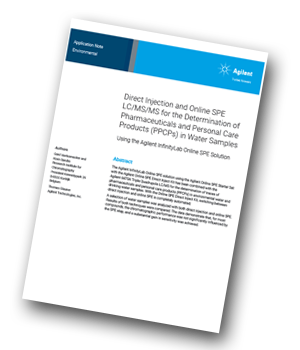This study outlines the analysis of pharmaceuticals and personal care products (PPCPs) in environmental and drinking water using direct injection LC/MS and online SPE.
 Introduction
Introduction
PPCPs are widespread in daily life, and traces can be found in most environmental water samples. Some of these compounds are detected as such, and others as degradation products or metabolites (metabolized by intake or in the environment, for example, by bacteria). According to a review by Petrie; et al.1 on these emerging contaminants in the environment, the presence of over 200 different pharmaceuticals has been reported in river waters in various countries. The chemicals are present in the environment as complex mixtures, and this situation can potentially lead to synergistic effects.1 Therefore, the influence of these contaminants on the environment is difficult to define and predict.
As PPCPs are present in low concentration in environmental samples, there is a demand for sensitive analytical methods. They must detect these chemicals at levels below ng/L (ppt) in various water matrices and, if possible, with minimal impact of these matrices on sensitivity and uptime of the analytical system. An additional challenge is that the compounds under investigation do not originate from one chemical family or class, and that their physicochemical properties are diverse. As a result, a single technique will not be able to cover all PPCPs present in the environment.
Advantages of online SPE
Regarding increasing sensitivity and automating sample preparation, online SPE is an interesting alternative to offline and manual pretreatments. The online SPE step concentrates and cleans up large volumes of water samples that can then be injected with no or only minimal manual intervention.
This application note demonstrates the benefit of online SPE for a selection of different PPCPs. Analyses were carried out using the Agilent 1290 Infinity II LC system coupled to a 6470A Triple Quadrupole LC/MS. The system was equipped with an Agilent Online SPE Starter Set and the Agilent Online SPE Direct Inject Kit. The advantage of the latter is that switching between online SPE (with generally large injection volumes) and direct injection with reduced delay volume can be fully automated without any hardware modification. This creates a flexible system for use in a wide variety of applications.
Results and Discussion
Due to the large volumes injected on the SPE column and the SPE process as such, care must be taken to maintain the chromatographic performance of the analysis. Therefore, the loading and elution conditions must be carefully selected and optimized. The impact of the loading solvent (for example, addition of acid, type of acid, and so forth) on the peak shape and recovery of analytes can be significant.
Conclusion
A method was developed for the analysis of a selection of PPCPs in water samples. Switching to online SPE enabled the detection of trace amounts in environmental samples that could not be detected by the direct injection approach. Although recovery was not optimized for all compounds, a notable gain in sensitivity could be observed without significant loss in chromatographic performance, and no excessive increase in analysis and sample preparation time. The amounts of PPCPs detected in real water samples were very similar with both techniques.
Reference
1. Petrie, B.; Barden, R.; Kasprzyk‑Hordern, B. A review on emerging contaminants in wastewaters and the environment: Current knowledge, understudied areas and recommendations for future monitoring. Water Res., 2015, 72, 3–27.




